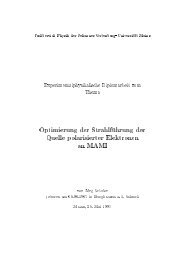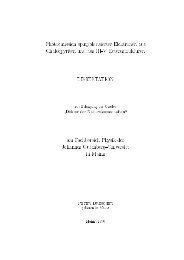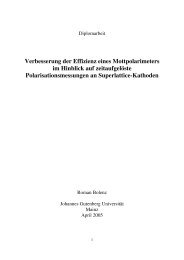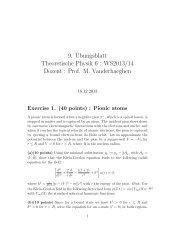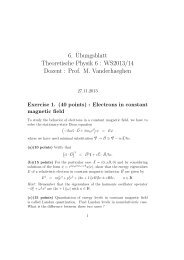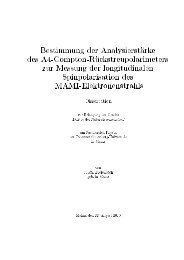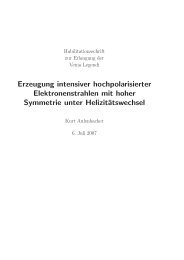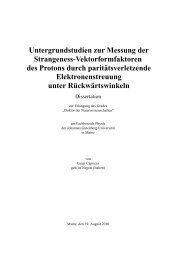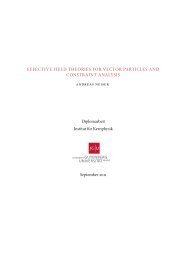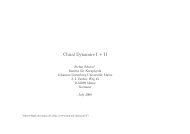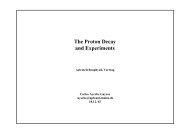Aufbau einer gepulsten Quelle polarisierter Elektronen - Institut für ...
Aufbau einer gepulsten Quelle polarisierter Elektronen - Institut für ...
Aufbau einer gepulsten Quelle polarisierter Elektronen - Institut für ...
Erfolgreiche ePaper selbst erstellen
Machen Sie aus Ihren PDF Publikationen ein blätterbares Flipbook mit unserer einzigartigen Google optimierten e-Paper Software.
P. Hartmann et al. / Nucl. Instr. and Meth. in Phys. Res. A 379 (1996) 15 – 20 17<br />
Faradaycup<br />
Mottdetector and<br />
wire scanner<br />
Deflector<br />
Photocathode<br />
The maximum deflection angle is given by<br />
tanα = eµ 0λ 0<br />
πl<br />
<br />
m 0 γπc H max sin<br />
βλ 0<br />
(2.1)<br />
Spectrometer<br />
E<br />
e-bunch<br />
Slit<br />
Klystron<br />
B<br />
TM 110<br />
Photodiode<br />
RF Source<br />
2.45 GHz<br />
Laser beam<br />
Mira 900 Laser<br />
76.54 MHz<br />
Phaseshifter<br />
Synchrolock<br />
-32<br />
where e is the electron charge, µ 0 the magnetic<br />
susceptibility, m 0 γ the relativistic electron mass, λ 0<br />
the vacuum wavelength of the rf, H max the maximum<br />
magnetic field on the cavity axis and l the cavity<br />
length. The cavity length is optimized for a maximum<br />
deflection angle of the 100 keV electron beam at a<br />
given input power P. The phase resolution is<br />
Electron bunch analysis<br />
Laser pulse generation and synchronization<br />
Fig. 4. Principle of the measurement is a radiofrequency<br />
streak method. On the right side the laser pulse<br />
generation and synchronization to the MAMI rf is<br />
shown. The left part of the sketch shows the electron<br />
bunch analysis with the TM 110 deflector cavity.<br />
2.3. Electron beam transport<br />
The electron beam transport system consists of a set<br />
of five quadrupoles and two double solenoid lenses<br />
along the beamline in Fig. 2. An achromatic, non–<br />
isochronic alphamagnet [18] separates it from the incident<br />
laser beam. Its phase focussing effect due to the<br />
non–isochronicity has been estimated by a homogenuous<br />
field calculation to be 0.005 ps per electronvolt<br />
energy spread. Its effect on the bunchlength measurement<br />
can be neglected for the measurements presented<br />
below. The last double solenoid focusses the beam<br />
on the entrance slit of an electron spectrometer.<br />
2.4. Phase analyzer<br />
The basic concept of the electron bunch analysis is a<br />
radiofrequency streak method (see Fig. 4). This method<br />
transforms the phase (time) dependent intensity<br />
of the electron bunch into a transverse spatial profile.<br />
The electron beam is wobbled over the narrow entrance<br />
slit of the electron spectrometer. Since the laser is<br />
synchronized to the wobble radiofrequency, a stable<br />
spatial image of the phase dependent intensity profile<br />
of the bunch is generated. This spatial pulse image<br />
can be shifted over the slit by varying the phase of the<br />
laser pulses relative to the radiofrequency. By measuring<br />
the dependence of the transmitted current on<br />
the phase shift, the phase dependent intensity profile<br />
is sampled.<br />
For beam wobbling we use a cylindrical TM 110 resonator<br />
(see also Fig. 4) as described in references<br />
[19,20]. The beam is deflected by the transverse magnetic<br />
field of the TM 110 mode on the symmetry axis<br />
of the cavity. To set the deflection plane exactly perpendicular<br />
to the slit, two metallic rods are installed<br />
at suitable positions inside the resonator.<br />
qσ<br />
δφ rms =<br />
2 x + w2<br />
12 180 o<br />
<br />
(2.2)<br />
L π tanα<br />
with slit width w, beam spot size σ x and distance L<br />
between cavity and slit. With P =41W,w =20µm,<br />
σ x = 0.25 mm and L =1mwegetδφ rms =1 o . This<br />
corresponds to a rms time resolution of 1.1 ps at 2.45<br />
GHz.<br />
2.5. Electron Spectrometer<br />
The electrostatic electron spectrometer consists of<br />
two toroidal condensator plates [21], set to 9.26<br />
kV. The ratio of the two toroidal radii of curvature of<br />
0.85 is chosen to form a stigmatic image of the incident<br />
beam spot. The energy scale is calibrated by<br />
measuring the position of the image of the entrance<br />
slit for different acceleration voltages. With an entrance<br />
slit of 20 µm width the dispersion is determined<br />
to 6.95 µm/eV and the energy resolution is better than<br />
15 eV at 100 keV. To transform an incident longitudinal<br />
beam polarization into a transverse polarization,<br />
that can easily be analyzed by Mott scattering, the deflection<br />
angle is choosen to be 107.7 o . According to<br />
the BMT–Formula [22] the electron spin precession<br />
angle is 17.7 o .<br />
2.6. Mott analyzer<br />
In the image plane of the spectrometer the scattering<br />
targets for the Mott analyzer are mounted on a precisely<br />
movable target holder. They consist of 10 to<br />
50 nm thick gold layers on Pioloform [23] carriers.<br />
These targets of different thickness have been used<br />
to obtain their effective Sherman function by a foil<br />
thickness extrapolation [24]. Two silicon surface barrier<br />
detectors at 120 o scattering angle define the scattering<br />
plane perpendicular to the deflection plane of<br />
the spectrometer. Their counting rate asymmetry<br />
A = N L ; N R<br />
N L + N R<br />
(2.3)<br />
is proportional to the beam polarization. The beam<br />
polari-



